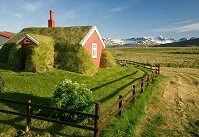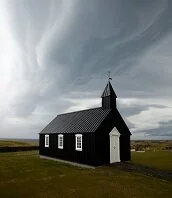Architecture of Iceland

Traditional house
Iceland's architecture is similar to Nordic architecture in many ways, first among those similarities being that most of the country's early buildings were constructed from wood or mud, giving the visitor today few early surviving examples of traditional dwellings.

Church in the country
Turf houses have been built since people first arrived in Iceland in the 800 or 900s, but these rarely last. Some are still being built today in a similar style and many folk museums also contain examples of these domestic buildings, but none are from the 800 or 900s.
Even as late as the 1700s most buildings were constructed from wood, which became a common building material in the 1000s with the introduction of Christianity and the building of churches. Most of the larger wooden churches were stave churches, however most of the remaining ones in the world today are in Norway, as there are no remaining stave churches still standing in Iceland.